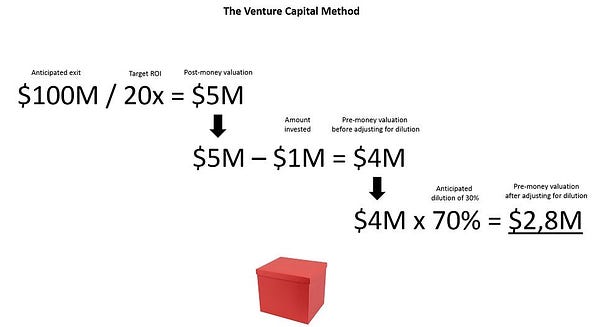Valuation: An investor’s perennial dilemma - Part 2
Hello, and welcome back to the Step by Step newsletter!
Thank you for opening this week’s edition of the newsletter. Last week we talked about Scorecard Valuation Method, a pre-money valuation method used by angel investors.
This newsletter is part two of three posts about valuing a start-up. This time we are talking about The Venture Capital (VC) Method.
Pre-money Vs. Post-money valuations
Let’s first discuss pre-money and post-money valuations.
As Alex Banks, co-founder of Tribescaler, put it in such simple terms


Venture Capital Method
Moving on to the Venture Capital Method
The VC valuation method was first introduced in 1987 by Harvard Business School Professor Bill Sahlman. It works out pre-money valuation by first determining post-money valuation using industry metrics.
The Venture Capital (VC) method is an assessment for valuing start-ups and high-growth businesses.
How does it work?
The method is quite simple and stems from the following equations:
ROI = terminal value / post-money valuation;
Post-money valuation = terminal value / anticipated ROI
Terminal Value - is the anticipated selling price (or investor harvest value) for the company at a specific date in the future
Anticipated selling price - this can be estimated by establishing a reasonable expectation for revenues in the year of the sale and, based on this, estimating earnings in the year of the sale from industry-specific statistics.
Anticipated ROI - you’d generally anticipate returns of 10X - 40X as per the norms of early-stage investments.
Let’s take an example and walk you through this -
Assuming an IT Company has a revenue of 200 crores and expects a profit of 15% (30 crores), you would calculate the terminal value using the industry-specific Price to Earnings Ratio (PE Ratio), so in this case, our PE ratio would be approximately 30X, making our terminal value 900 crores.
From the values above:
Post-money valuation = 900 cr / 20X = 45 crores
Now assuming that the founder needs five crores to remain in a positive cash flow, our pre-money valuation would be -
Pre-money valuation = Post-money Valuation – Investment = 45 crores - 5 crores
Pre-money Valuation = 40 crores
What’s the Price Earning Ratio?
With a quick google search, you can find that:
The price-earnings ratio, also known as P/E ratio, P/E, or PER, is the ratio of a company's share price to the company's earnings per share. The ratio is used for valuing companies and for finding out whether they are overvalued or undervalued.
You can read up in depth here - https://medium.com/crypto-currently/a-quick-primer-on-p-e-ratios-5bb3e7320880
What do we do if there are subsequent investments?
The easiest way is to reduce the pre-money valuation by the estimated level of dilution from later investors.
Ready to start investing?
It is recommended to use multiple methods to come to an accurate valuation, and experience is excellent for anticipating values and returns.
Check out the last newsletter to learn about another easy valuation method, Scorecard Valuation Method. And keep in touch for more valuable methods that we will talk about in the upcoming newsletter.
Read up on other factors that affect valuation and mistakes you should avoid here.
How can Sparklehood help?
Don’t forget to sign up below for the Angel Investor Cohort for guidance in your journey as an angel investor and premium deals.
With mentors such as Ajeet Khurana and Vineet Saxena in the past, you know you’re in excellent hands with tons of learning opportunities from your peers.





